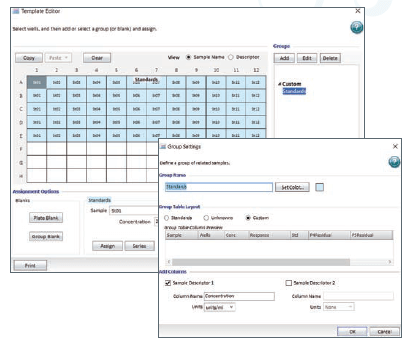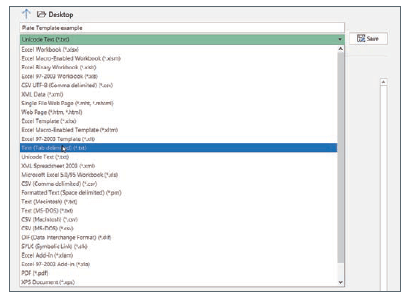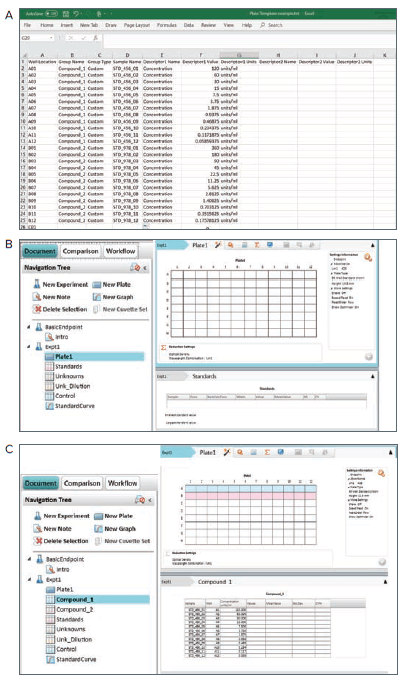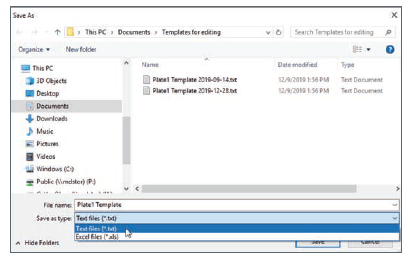
Application Note
Importing sample information into SoftMax Pro Software using template tools
Caroline Cardonnel | Sr. Applications Scientist | Molecular Devices
Introduction
SoftMax® Pro 6 or 7 Software enables the entry of some sample information via the template editor. The sample name and two descriptors can be added to customize a protocol (Figure 1). In addition, the import and export functionality of the SoftMax Pro Software allows for importing plate templates as .xls or .txt files. This is particularly useful for high throughput or if the sample information is already available in another software (i.e. Excel). This technical note provides a step-by-step procedure to import a template file from Excel.

Figure 1. Template editor windows in the SoftMax Pro 6 or 7 Software.
Creating a compatible template file
On the Home tab of SoftMax Pro Software, the template tools enable the import of template information into a plate section from a tab-delimited ASCII text file in Unicode (UTF-8) format. Template files can be prepared outside the SoftMax Pro Software and then imported when samples are ready to be run.
The best way to obtain the correct format for template import is to export a template from SoftMax Pro Software and modify the contents of the resulting file.
To export a template, follow the next few steps:
- In the Navigation Tree, select the source plate section.
- On the Home tab, click Export (

-
- Navigate to the location where you want to save the template file.
- In the File Name field, enter a name for the file.
- Click the Save As Type drop-down and select text files (*.txt) or Excel files (*.xls). Text files are saved in a tab-delimited format.\
-
- Click Save. This file can now be open and updated in Excel.
Updating and modifying the template file in Excel
When template data are saved as a tab delimited ASCII text file in Unicode (UTF-8) format, the template file consists of ten columns of data separated by tabs (Figure 2). Each line of the file provides information for a single well in the plate.

Figure 2. Examples of exported template files opened in Excel. A) is the exported file from a SoftMax Pro document where wells were not assigned in the plate template, while B) was obtained from a SoftMax Pro document where wells were assigned in the plate template.
When you export template information, the first line of data contains template information for well A1, the second line of data contains template information for well A2, and so on, such that a line is created in the export file for each well in the plate. If no template information exists for a well in a plate, the corresponding line in the file is left blank.
The order of the import template information must match the export order, and each column should have the correct format: text, number, or alphanumeric (Table 1). Column C represents the group section format and therefore the analysis carried out in the tables in SoftMax Pro Software. It can be either Standards, Unknowns, or Custom. If you have added additional columns in a group section in SoftMax Pro, “Custom” will be displayed in this column. Column D is the sample name and can be entered with a barcode. In the group table in SoftMax Pro, Samples will be listed according to their name in alphanumerical order, therefore you should put a “0” before a single digit number to keep the correct order. Blank lines in the file are assigned to wells, with no template assignment.
Table 1. Description of the Template file. When not specified, the entry can be text, numerical or alphanumerical.
Once you have adjusted the template file, save the document as a text file in tab-delimited format (Figure 3) and close Excel. If Excel is still open, you will see an error message in SoftMax Pro Software while importing the template (Figure 5).

Figure 3. Saving the template file in Excel as a text file in tab-delimited format.

Figure 5. Possible error messages that can occur during template import. A) is the error message generated when Excel is still open while doing the import into SoftMax Pro Software. B) is the error message generated when one well in the Excel template file has the wrong format (e.g., text instead of number).
Importing a template
If you have followed the guidelines listed in Table 1, importing the updated template can be done in just a few steps in SoftMax Pro Software:
- In the Navigation Tree, select the destination plate section.
- On the Home tab, click Import (

-
- Navigate to and select the <template>.txt file you want to import.
- Click Open. The template will be added to the plate section and additional tables will be generated according to the imported template file (Figure 4).

Figure 4. Example of template file import in SoftMax Pro Software. A is the adjusted Excel template file from Table B in Figure 2. Two groups were added (Compound 1 and Compound 2), the sample names were changed, and the concentration was corrected to meet assay criteria. B is the SoftMax Pro basic endpoint data file before the template import: there is no template in the plate section (blank plate), no data analysis, and four groups are present in the navigation tree. C is the SoftMax Pro basic endpoint data file after the template import: the template is visible in the plate section with color coded groups, the navigation tree has 2 new groups, and the Compound 1 group table shows the correct imported concentrations.
Conclusion
This technical note shows how to import a template file into SoftMax Pro Software from Excel. When the template is available in an Excel-compatible format, an Excel macro can be designed to update the template file automatically for a more secure and rapid method.

